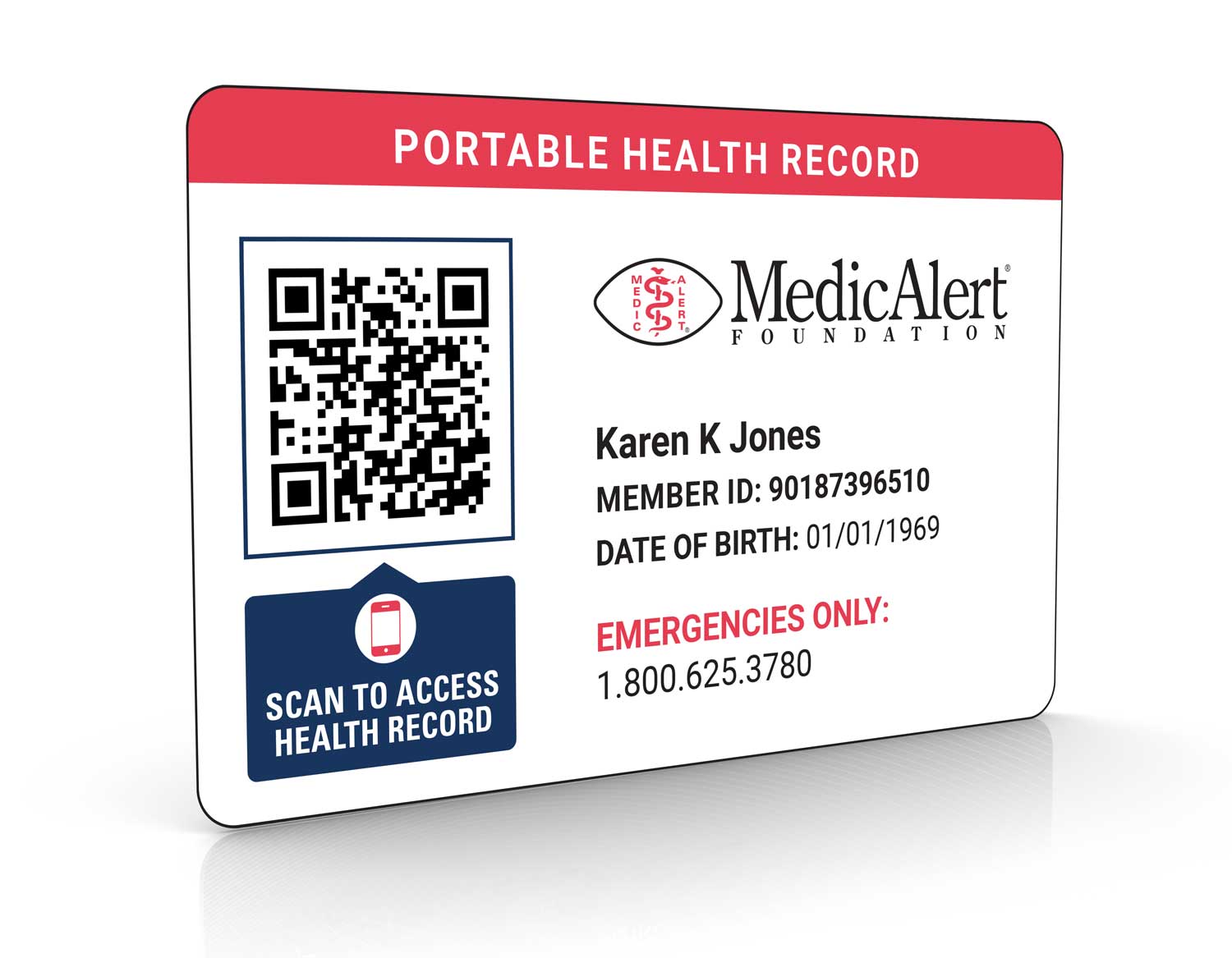Help others help you. Wear a medical alert ID bracelet or necklace engraved with important information for emergency responders and healthcare providers
Centers for Disease Control & Prevention

Medical IDs for Sjogren's Syndrome
The confidence to live with Sjogren's syndrome
Sjögren’s syndrome (SS) affects millions of people worldwide. While the condition usually isn’t life-threatening, if left untreated, it can lead to serious complications involving the nervous system, kidneys, and lungs. There is no cure for Sjögren’s syndrome. However, when promptly and properly diagnosed, SS can be effectively treated with interventions ranging from over-the-counter (OTC) remedies and complementary and alternative medicine (CAM) to medicated eye-drops and prescription drugs.
While having effective treatment options for SS is a positive thing, many drugs have the potential to interact negatively with other drugs and substances. Further, any treatment can cause mild to serious side effects.
These are just a few reasons why people living with this condition should wear a MedicAlert medical ID for Sjogren’s syndrome.
How MedicAlert protects those living with Sjogren's syndrome
One thing you shouldn’t worry about is what could happen if there’s an emergency. MedicAlert’s protection plans offer benefits that extend beyond the ID, providing safety and peace of mind for people living with Sjogren’s syndrome, their families and caregivers.

24/7 Emergency Response
Our team provides first responders the information they need to provide fast, accurate care.

Digital Health Profile
All your vital information, all in one place for you and your caregiver.

Emergency Contact Notification
In an emergency, we connect families so that no one is alone in a crisis.

Patient Instructions
Share the information that’s important to your care, such as use of rescue medications or contraindication for tests like MRIs.
Pair a medical ID for Sjogren’s syndrome with the protection plan that’s right for you.
What exactly is Sjögren’s syndrome?
Sjögren’s (pronounced show-grins) syndrome is named after Swedish physician Henrik Sjögren who, in the 1930s, described a group of women—many with chronic arthritis—who had extreme dry eyes and dry mouth. Today, Sjögren’s syndrome is described as an autoimmune disorder that can affect the entire body (systemic), rather than one or two body parts or organs. Two of the most common symptoms of Sjögren’s syndrome are dry mouth and dry eyes. Other symptoms can range from rashes and joint stiffness to dry cough and fatigue.
As many as four million Americans are living with SS, with an estimated 2.5 million undiagnosed cases. The condition affects approximately half of all individuals living with rheumatoid arthritis (RA).
What causes Sjögren’s syndrome?
There are over 100 known autoimmune diseases. In addition to Sjögren’s syndrome, some of the most common include RA, ulcerative colitis, psoriasis, lupus, Crohn’s disease, multiple sclerosis (MS), and psoriatic arthritis. If you have an autoimmune disease, your immune system mistakes healthy cells for foreign cells or “invaders” such as viruses, bacteria, and tumor cells. When this happens, the immune system attacks the body instead of protecting it.
While there are some theories as to why your immune system might turn on you, scientists aren’t entirely sure why some people develop autoimmune disorders such as Sjögren’s syndrome. According to Mayo Clinic, scientists suspect that certain genes may put people at risk of developing SS. A triggering mechanism, such as an infection with a particular virus or strain of bacteria, may also play a role. Further, Sjögren’s syndrome is most common in people in their 40s and 50s, and the condition predominantly affects women, so it’s possible that age and gender may increase the risk of developing SS.
When the body’s immune system mistakes healthy cells for invaders, this can cause a variety of symptoms including pain, fatigue, rashes, nausea, headaches, dizziness, and more. Specific symptoms depend on the type of autoimmune disorder.
What to engrave on MedicAlert medical IDs for Sjogren's syndrome:
MedicAlert offers free custom engraving on all our Sjogren’s syndrome bracelets and medical ID products. Engravings on medical IDs for Sjogren’s syndrome should include any critical medical information that can protect and save lives in an accident or medical emergency, for example:
- Designated physician information
- Sjögren’s syndrome, other medical conditions
- Medications
- Emergency contact information

Sample engraving. Consult our team if you need help engraving your medical ID for Sjogren’s syndrome.
What are the symptoms and complications of Sjögren’s syndrome?
As mentioned, dry eyes and dry mouth are two of the most common symptoms of Sjögren’s syndrome. In a person with SS, the tear glands (lacrimal glands) and salivary glands, primarily the glands that sit just in front of the ears on each side of the face (parotid glands), are the target of a misdirected attack by the immune system. When this happens, tear production decreases and the salivary glands become swollen. Decreased tear production can cause dry eyes, burning, itching, and grittiness (feeling like you have sand in your eyes). Swollen salivary glands, can cause dry mouth (feeling like your mouth is full of cotton) making it difficult to swallow or speak.
Sjogren’s syndrome can also cause one or more of the following symptoms:
- Joint pain, swelling, and stiffness
- Persistent dry cough
- Prolonged fatigue
- Skin rashes or dry skin
- Vaginal dryness
While the immune system in people living with SS first targets the glands that make saliva and tears, it can also launch an attack on other parts of the body including the:
- Kidneys, resulting in malfunctioning of the kidneys
- Liver, leading to infections and diseases of the liver
- Lungs, leading to airway abnormalities, interstitial lung disease (ILD), and lymphoproliferative disorders
- Nerves, which can affect the coordination of heartbeat, respiration, and gastric motility
- Thyroid, leading to thyroid disorders, especially autoimmune thyroiditis
According to the American College of Rheumatology (ACR), children and young adults typically present with different signs and symptoms of Sjögren’s syndrome compared to older adults. The most common initial symptoms for children and younger adults include joint pain (arthralgias) and swelling of the parotid glands. The pediatric population may present with neurologic and kidney issues. Dryness features may or may not be present at diagnosis for children and young adults.

MedicAlert Foundation is proud to partner with NORD to provide support, educational resources and tools to help those affected by rare disease live more safely and confidently.
How do you diagnose Sjögren’s syndrome?
On average, it takes three years from the time symptoms start before being diagnosed with Sjögren’s syndrome. The condition is often undiagnosed or misdiagnosed because SS symptoms often overlap with or mimic those of other autoimmune conditions, allergies, chronic fatigue syndrome, side effects from medications, and even menopause. Doctors often end up treating each symptom individually, not realizing that collectively, the symptoms are caused by systemic disease.
There is no single test to diagnose Sjögren’s syndrome. However, doctors have a number of tests and evaluation tools that can be used together to reach a definitive diagnosis. These include:
- Lip biopsy to test the salivary glands.
- Blood tests that can detect autoantibodies that often occur in this disease.
- Dental exam, including head, neck, and intraoral evaluation.
- Eye exam to detect and assess for damage on the outer surface of the eyes.
- Physical exam to examine the glands and joints, and assess symptoms.
- Schirmer test to measure the dryness of the eyes.
- Sialometry test to assess decreased saliva production.
How do you treat Sjögren’s syndrome?
Treatments for Sjögren’s syndrome are aimed at controlling individual symptoms of the disease and preventing complications. Treatment is usually lifelong, and may include:
- Hydroxychloroquine (Plaquenil), a drug designed to treat malaria that can control systemwide symptoms by quieting or slowing down the immune system.
- Low-dose prescription steroids such as prednisone to help control inflammation.
- Methotrexate (Trexall), a prescription drug that suppresses the immune system.
- OTC arthritis medications, such as acetaminophen (Tylenol, Tylenol Arthritis) and naproxen (Aleve), to control pain and inflammation.
- OTC non-steroidal anti-inflammatory drugs (NSAIDs), such as ibuprofen (Advil), to control pain and inflammation.
- Pilocarpine (Salagen) and cevimeline (Evoxac), prescription drugs that can increase the production of saliva and tears.
- Prescription eyedrops, such as cyclosporine (Restasis) or lifitegrast (Xiidra), for moderate to severe dry eyes.
When prescription eye drops don’t work for dry eyes, a procedure known as punctual occlusion might provide relief. This minor surgery involves sealing the tear ducts that drain tears from the eyes. Collagen or silicone punctual plugs are inserted into the ducts to help preserve the tears.
In some cases, Sjögren’s syndrome symptoms can be managed well with self-care measures such as:
- Artificial saliva, in the form of sprays and lozenges.
- Artificial tears, eye lubricants, or both to keep the eyes moist.
- Avoiding hot water.
- Brushing teeth and flossing after every meal.
- Chewing sugarless gum or citrus-flavored candies to increase saliva production.
- Increasing humidity in the home, which can help keep the mouth and eyes from getting dry.
- Nasal saline sprays to moisturize and clear nasal passages.
- Lightly patting skin dry after showering or applying moisturizer to wet skin (then air dry) to avoid skin irritation.
- Quitting smoking, which can exacerbate dry mouth.
- Seeing your dentist every six months (dentists are often the first to detect oral SS symptoms).
- Using daily topical fluoride treatments and antimicrobial mouthwashes.
- Vaginal moisturizers and lubricants.
- Wearing rubber gloves when doing dishes.
How medical IDs for Sjogren's syndrome combined with MedicAlert Membership provide peace of mind
If you are living with this condition, MedicAlert medical IDs for Sjogren’s syndrome can protect you if you are in an accident or have another medical emergency. A Sjogren’s syndrome bracelet lets emergency responders know that you are living with a condition that requires medication, so drug interactions can be avoided. SS can also cause many of the same symptoms as other conditions. A MedicAlert medical ID can let emergency responders know that you are living with Sjögren’s syndrome, so a delayed or inaccurate diagnosis can be avoided. This can help ensure fast and accurate care in an emergency.
- We’re your voice: If you can’t speak for yourself due to a medical emergency, your ID will speak for you – informing others about your Sjogren’s syndrome and any medications you’re taking.
- 24/7 emergency protection: In an emergency, the MedicAlert team will relay all of your critical medical information to first responders, no matter where or when your emergency happens.
- Always connected: You should never be alone in an emergency. That’s why MedicAlert will reach out to your designated contacts if you are unable to do so.
- Live with peace of mind and confidence: MedicAlert will be there for you every step of the way. You’ll have the confidence and freedom to live your life with Sjogren’s syndrome, knowing we’ve got you covered.
Sources: American College of Rheumatology (ACR); American Medical Association (AMA)-JAMA Network; Brigham and Women’s Hospital; Cleveland Clinic; European Respiratory Society (ERS); Johns Hopkins Medicine; Johns Hopkins Sjögren’s Center; Mayo Clinic; Mount Sinai; National Institute of Arthritis and Musculoskeletal and Skin Diseases (NIAMS); National Institutes of Health (NIH)-National
DISCLAIMER: THIS WEBSITE DOES NOT PROVIDE MEDICAL ADVICE. The information in this article is presented for educational purposes only and is not intended as a substitute for professional medical advice, diagnosis and treatment. Always seek the advice of a physician or other qualified healthcare provider for any questions you may have regarding a medical condition or treatment.







